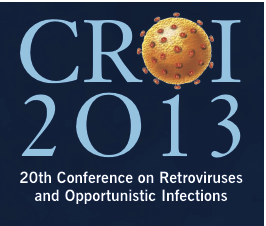Safety of transplacental raltegravir in neonates and washout pharmacokinetics
1 April 2013. Related: Conference reports, Antiretrovirals, Pregnancy, PK and drug interactions, CROI 20 (Retrovirus) 2013.
Polly Clayden, HIV i-Base
 Use of raltegavir (RAL) in pregnant women is on the increase, not only due to its widening use generally, but because of its good transplacental transfer and rapid first and second phase viral decay.
Use of raltegavir (RAL) in pregnant women is on the increase, not only due to its widening use generally, but because of its good transplacental transfer and rapid first and second phase viral decay.
BHIVA guidelines recommend women who are untreated in pregnancy or do not initiate treatment until after 28 weeks receive it as part of their regimen. These guidelines also recommend it as an option for pregnant women requiring intensification.
IMPAACT P1097 is a US multicentre, washout pharmacokinetic (PK) trial in neonates born to HIV positive women receiving RAL. Promising early data from 12 mother/infant pairs, presented last year at the PK workshop, showed cord blood to maternal plasma concentration ratio of approximately 1.5 and no safety issues in the first 20 weeks of life. [1,2] Data presented at CROI 2013 in a poster, authored by Diana Clarke and colleagues from the study team, showed similar findings for 22 mother/infant pairs.
RAL is approved in children two years old and above. The drug is metabolised primarily by UGT1A1 – which is immature in infants and has much reduced activity, so there might be competition with biliruben (that uses the same metabolic pathway) for albumin binding sites.
Full term infants of normal birth weight, born to mothers who had received at least two weeks of RAL 400 mg twice daily, as part of their ART regimen, were eligible for PK sampling. Cord blood and a single maternal blood sample were collected at delivery. Infant blood samples were collected 1-5, 8-14, 18-24, and 30-36 hours after birth. RAL concentrations were measured using a validated HPLC-MS-MS method. Infant t1/2 was estimated using terminal 2 or 3 concentration-time points. Infant safety was evaluated up to 6 months.
Over half (59%) of the mothers were African American and 55% overall delivered by Caesarean section. The infants were a mean gestational age of 38 weeks at birth. Evaluable PK samples were obtained from 19 mother/infant pairs.
Median RAL plasma concentration values were: cord blood, 957 ng/mL (range 24-3974); maternal at delivery, 540 ng/mL (range 12-5809) and ratio of cord/maternal blood, 1.48 (range 0.32-4.33). Median infant plasma concentrations were 671 ng/mL (range 13 -2672) at 1-5 hours, decreasing stepwise over the time points to 291 (range BLQ – 1402) at 30-36 hours.
RAL concentrations were above the IC95 (16ng/mL) up to the last time point in all but one infant. RAL concentrations increased after birth before decreasing in 50% of infants. The median infant terminal t1/2 was 26.6 hours (range 9.3-184). No clinical or laboratory abnormalities associated with RAL were observed during this evaluation and there were no HIV transmissions.
Neonatal RAL elimination was highly variable. The investigators noted this suggested potential roles for developmental aspects of neonatal UGT1A1 enzyme activity, redistribution, and/or enterohepatic recirculation of RAL.
The next step for this programme is to investigate potential neonatal dosing regimens (IMPAACT P1110).
References:
- Clarke DF et al. Raltegravir (RAL) pharmacokinetics (PK) and safety in neonates: washout PK of transplacental RAL (IMPAACT P1097). 13th International Workshop on Clinical Pharmacology of HIV Therapy. Barcelona, Spain.16 -18 March 2012. Oral Abstract: O_22.
- Clayden P. Washout pharmacokinetics of transplacental raltegravir in neonates. HTB, 1 June 2012.
https://i-base.info/htb/16580 - Clarke D et al. Raltegravir pharmacokinetics and safety in neonates (IMPAACT P1097). 20th CROI, 3-6 March 2013, Atlanta, GA, USA. Poster abstract 974.

